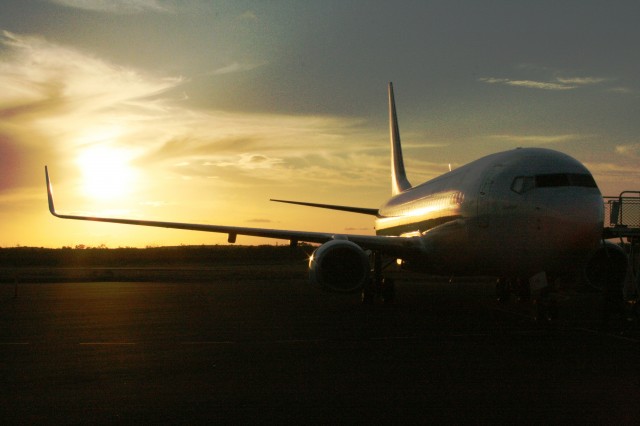
A Boeing 737-800NG readies for a dusk departure.. Photo by Owen Zupp.
Last week, I shared a story written by Owen Zupp, comparing the Boeing 737 classic to the next generation. What better way to compare them than how they fly? Luckily for us, Zupp has been able to fly both and is willing to share. Be sure to also follow Zupp on his own blog about aviation. Here is his story on the 737 in his own words…
The 737NG is a great all-rounder. In the context of a comparison with the Classic, there are distinct differences from a pilot’s perspective. From handling characteristics and performance to ’œtwo cup holders instead of one’, there are a myriad of differences in the newest steed from the 737 stable. Some are subtle, some are distinct, but the vast majority are improvements for the better while still meeting the ’˜common type’ constraints.
The majority of pilot’s speak of the NG with admiration. Much of this stems from the re-designed wing and winglets which provides enhanced speed, range and performance. The wing is also a major player from a handling viewpoint. The NG could be described as a ’œstraight line aeroplane’ when compared to the Classic. More like its bigger brothers, the increased weight and enhanced wing of the 737NG translates to higher energy that, in turn, calls for greater planning and anticipation when decelerating. On descent the NG can easily accelerate to its upper speed limit of the ’˜Barber’s Pole’ and whilst the Classic was quite at home being wheeled around the circling area and washing off speed, the NG is a more ’˜slippery’ candidate and needs to be handled on descent accordingly. In terms of turbulence penetration, the Classic possesses a seemingly more rigid wing that tends to ’œpunch through turbulence’, whilst the NGs wing is more ’œgiving’ and tends to ride the turbulence better. Again, this is a feature the NG seems to have in common with the larger aircraft from Boeing.
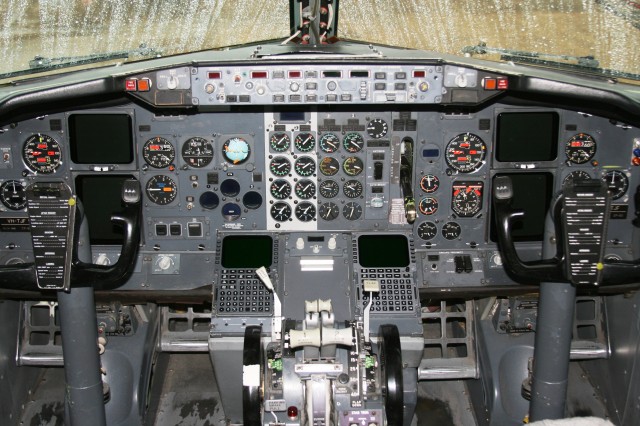
The analogue flight deck of a Boeing 737-400 'Classic' in a 'powered down' state. Photo by Owen Zupp.
The enhanced performance of the NG also received high praise. In the 737-300, the 1700 nm into wind sector between Australia’s coastal capitals of Sydney and Perth was not possible whereas such sectors are not a problem for the higher powered -800. Additionally, the capability to climb directly to 41,000 feet can prove an operational bonus when performance permits, allowing that extra 4,000 feet to get above more of the weather.
Whilst cockpit ergonomics seemed to have changed little, particularly with reference to the overhead panel, the accuracy of the GPS navigation system is a significant improvement for those up the sharp end. Constantly updated, there is no tendency for the map display to ’˜drift’. The outside world is reflected with precision on the cockpit presentation, which assists greatly in visual manoeuvres such as circling off the bottom of an approach. This was not the case with the older IRS driven maps.
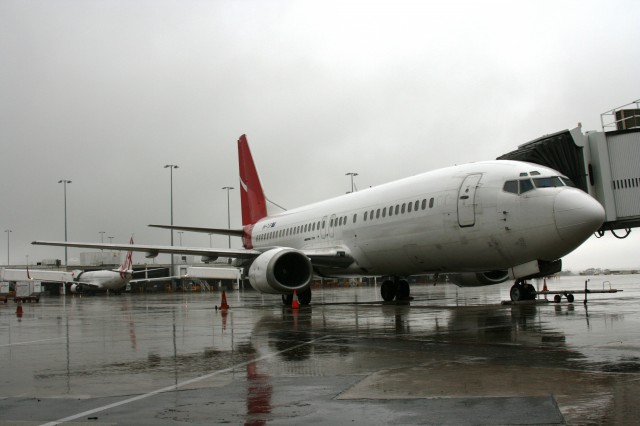
A retiring Boeing 737-400 waits at the gate prior to it's final departure. Photo by Owen Zupp.
The longer fuselage of the -800 offers a potentially limiting geometry on take-off, making a ’˜tail strike’ a real possibility if the rotation is too fast. Landing the newer variant is also notably different aside from the longer landing distance that is required. With the shorter winged ’˜Classic’, a few knots above reference speed in the flare did not seem to alter the touchdown point significantly. Once its mind is made up to land, the spot is fairly fixed. However, the carriage of excess speed, or flaring too early in the NG can result in the wastage of significant amounts of precious runway. The enhanced wing of the NG means that the aircraft wants to keep flying and will happily float as it slowly decelerates in ground effect. For pilots flying the dual variants it is always worth self briefing this point on approach when hopping from type to type.
Walking around the NG, there seems to be only subtle visible changes to the 737 beyond the prominent winglets. It is longer, wider and with a higher fin than the Classic, but unless it is side by side with its ’˜parent’ these differences are all matters of scale. However, the aircraft does sit higher than its Classic forerunner and consequently allows greater clearance for the CFM56-7 engines that are slung beneath the wings. The trademark flat-bottomed cowlings of the ’˜dash 3’ CFMs are not quite so flat and lean towards more conventional round cowlings. Additionally, since January 2005, Boeing has been rolling out the 737NG without the now familiar ’˜eyebrow’ windows above the crew’s main windows.
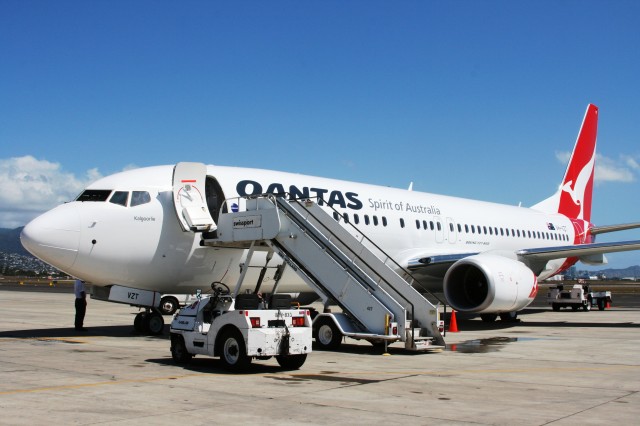
A new 737-800 at Honolulu enroute to Australia. Photo by Owen Zupp.
The Next Generation?
2012 sees the Boeing 737 turning 45. Even so, it is still a design seeking more efficient ways to achieve its designed tasks. This year Boeing announced improvements to engine and airframe that will equate to around 2% in fuel savings. For the passengers, Boeing have looked to the 787 and given the 737 a facelift with the ’˜Boeing Sky’ interior with newer sidewalls, LED lighting and bigger overhead lockers.
The 737 also has a proven track record that defies time as all marques of this Boeing are still gracing the sky. With such a bloodline it is not surprising that the 737 Next Generation has enjoyed success in the same vein as its predecessors. With ER (Extended Range) versions giving the type even longer legs; there are very few tasks that the 737NG can’t handle.
Forged from the legacy of another tremendous domestic stalwart, the Classic, it has built upon its strengths and alleviated most of the perceived shortcomings. And with the 737 Max now looming on the horizon, It finds that irrepressible the NG family has captured that quality of so many Boeing aircraft; a workhorse for the airline and a loved stallion by its crews.
BOEING 737 CLASSIC vs NEXT GENERATION
Part 1 | Part 2 | Owen’s Blog
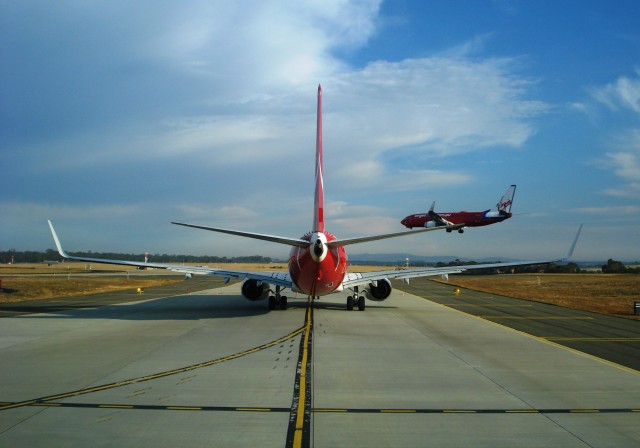
A QANTAS 737-800 awaits take-off clearance as Virgin 737NG lands. Photo by Owen Zupp.
Owen Zupp is a published author, journalist and experienced commercial pilot. With over 16,000 hours of varied flight experience he has flown many creatures, great and small, from outback Australia to all points across the globe. He holds a Masters Degree in Aviation Management and in 2007 his first book, Down to Earth, was published, tracing the combat experiences of a WWII RAF pilot from Dunkirk to D-Day and beyond. He also writes a blog on aviation on his website. This is a two-part story, written by Zupp, talking about his experience flying the Boeing 737 classic versus the 737 NextGeneration. Here is his story in his own words…
Introduction:
Somewhere across the globe a Boeing 737 takes off or lands every 5 seconds and over 1200 of their compatriots are aloft at any given time. With the 7000th aircraft rolled out in December 2011, the 737 has truly brought the term ’˜prolific’ to airliner production and considering the maiden flight of the 737-100 took place in 1967, it is quite appropriate that the latest metamorphism be dubbed the ’œNext Generation’.
With its title clipped to the more easily handled, ’œNG’, the ’˜next generation’ covers the -600 through to the -900 series of the 737. Of Boeing’s latest offering the 700 and larger 800s have gone on to dominate the skies, while the ’˜Max’ is still yet to come. The NGs predecessors, the -200, -300 and -400 had provided the backbone of short haul travel in a very similar way. Whilst the number of earlier models is ever dwindling, they have gone on to be referred to as ’˜The Classics’ as they reflect a last bridge between the analogue and digital flight deck. Whilst a highly visible transition, the clocks and dials are but one area of many in which the Classic has been superseded.
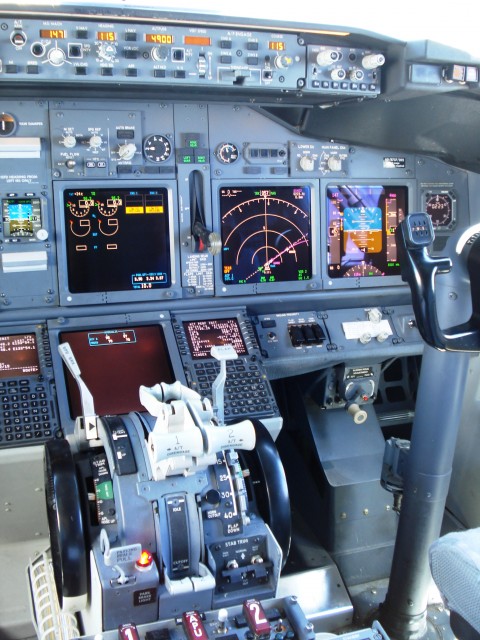
The flight deck of a Boeing 737-800. Photo by Owen Zupp.
737 Next Generation Development:
The 737NG program was launched in 1993 under the title of 737-X. Boeing recognized the time-tested qualities of the type, but needed to bring the efficiency of new technology and systems to its most enduring machine. Fundamentally, the 737-X was to fly higher, farther, faster and more fuel efficiently than its predecessor without evolving into a new machine requiring a new designator and certification. A challenging task to say the least.
Much of the efficiency revolved around the redesigned wing. With 25% more total surface area and potentially 30% more fuel capacity, the new wing has much to offer. Boasting a higher span than the Classic, the new wing is a more swept with a constant angle of sweep and double-slotted continuous span flaps. Gone is the double swept leading edge and characteristic ’˜kink’ of the earlier wing. Similarly, there have been changes to the leading and trailing edge flaps that have resulted in weight saving as well as aerodynamic efficiency. For all of the improvements to the aerofoil and lift augmentation devices, the most visible change to the wing and the aircraft generally, is the emergence of blended winglets on the 737.
The smooth, upward sweeping fairings at the tips stand a prodigious 2.4 metres and increase the span by a metre and a half. Simply put, the winglets benefit the aircraft through the reduction of induced drag and consequently improved operational and economic performance. Whilst yielding an impressive 4% saving in mission block fuel, the winglets also increase the 800s range by over 100nm. (Source: Boeing) Improved performance out of ’˜hot, high and humid’ airfields is another advantage of the blended winglet. In fact, this aerodynamic device has proved so successful that it is now being retrofitted to 757s as well as 737s.
The NG also sees the introduction of GPS to the 737 navigation system. Previously only equipped with dual Inertial Reference Systems (IRSs), the system relied upon ’˜updates’ from ground based VORs and DMEs to continually refine the aircraft’s present position. Without such updates, the pictorial presentation on the map display could be inaccurate requiring the crew to heavily rely on ’˜raw data’ from conventional radio navigation aids. GPS provides a far more consistently accurate map display for the crew and allows for more integration of the aircraft’s Lateral Navigation (LNAV) and Vertical Navigation (VNAV) systems. Additionally, the NG is equipped with a Predictive Windshear Warning and Enhanced Ground Proximity Warning System (EGPWS). This ’˜forward-looking’ form of the original GPWS provides improved terrain clearance by such mechanisms as Terrain Clearance Floor, Look Ahead and Runway Clearance Floor algorythms.
Efficiency and costs savings can also be achieved on the ground. Production line improvements saw the final assembly of a 737NG in a record-breaking 11 days in 2005. On the maintenance side, the NG was developed with an eye to reducing airframe maintenance costs by 15%. Comprised of significantly less parts than the Classic, the NG was also designed with far more ’˜ease of access’ for maintenance crews. Redesigned leading edges, landing gear, electronics, APU and the 15% more efficient CFM56-7 engines all contributed to the bottom line. In conjunction with improved maintenance documents, corrosion prevention and extended scheduled maintenance intervals, the 737NG has won the battle of the dollar over its forerunner.
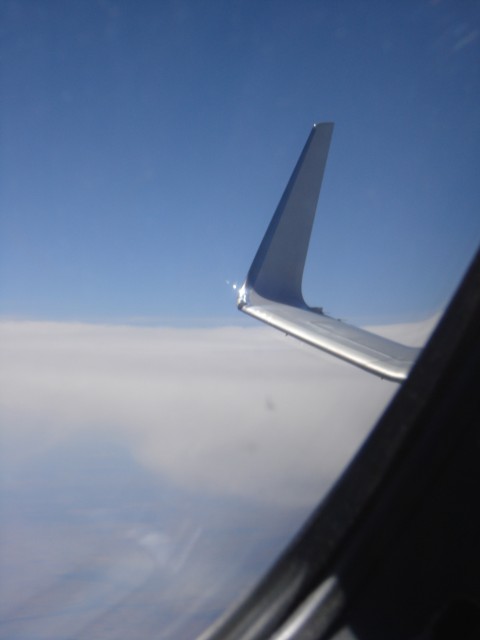
Looking back at the blended winglet of the 737NG. Photo by Owen Zupp.
On the flight deck, the 737NG strongly resembles its twin-engined big brother, the Boeing 777. The panel is dominated by the presence of 6 LCD panels arranged side by side, replacing the combination of EFIS and analogue that was found on the Classic. For the pilots, this means a degree of modification of their instrument scan from the vertical to the horizontal. The flight deck was designed in response to the demand by operators that a new type endorsement not be needed. As a consequence, the overhead panel closely resembles the Classic with its array of toggle switches and dials, though the operation of the system behind the switch may well be different.
As for achieving higher, faster, farther and more fuel efficient performance; Boeing delivered. The NG possesses greater range by more than 400nm over the earlier model, whilst topping out at FL410 (41,000 feet) as opposed to the Classic ceiling of FL370 (37,000 feet). With a typical cruise speed of 0.78M and a sprint capability to 0.82M, the NG draws away from the Classic’s average cruise of 0.745M, whilst all the while burning less fuel. Furthermore, depending on the cabin configuration, the -800 can achieve all of this while carrying around 40 more passengers than its predecessor. From humble beginnings as the 737-100 nearly 40 years ago, the 737 has kept pace with the times through ongoing development and improvement. The 737NG is no exception.
Technologically, some 737 NGs can be equipped with a ’˜Head-Up Guidance System’ or ’˜HGS’. The HGS 4000 system features a transparent drop-down screen in front of the Captain on which is projected an array of flight information, allowing the pilot to operate in lower visibility situations than would otherwise be possible. Head-Up Display (HUD) technology has been available for years on military aircraft and Alaska Airlines started flying HUD on their 727s back in the mid-80s and all of their 737-400s are equipped with the technology.
Some airlines have opted for the Vertical Situation Display (VSD) on their aircraft. The VSD displays the current and predicted flight path of the aircraft and indicates potential conflicts with terrain. The VSD is designed to enhance situational awareness on the flight deck and is yet another way in which the Next Generation is offering advances over its predecessor.
BOEING 737 CLASSIC vs NEXT GENERATION
Part 1 | Part 2 | Owen’s Blog






